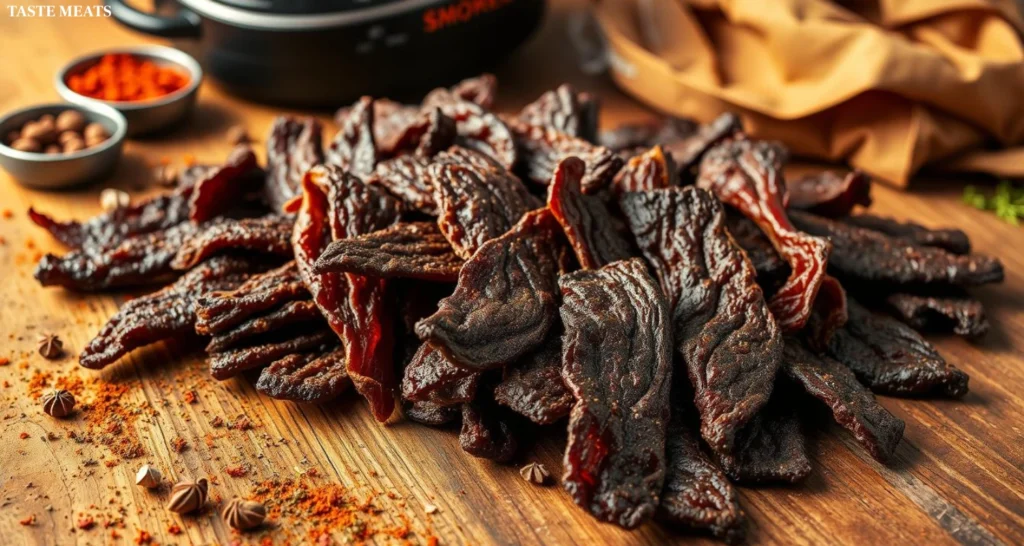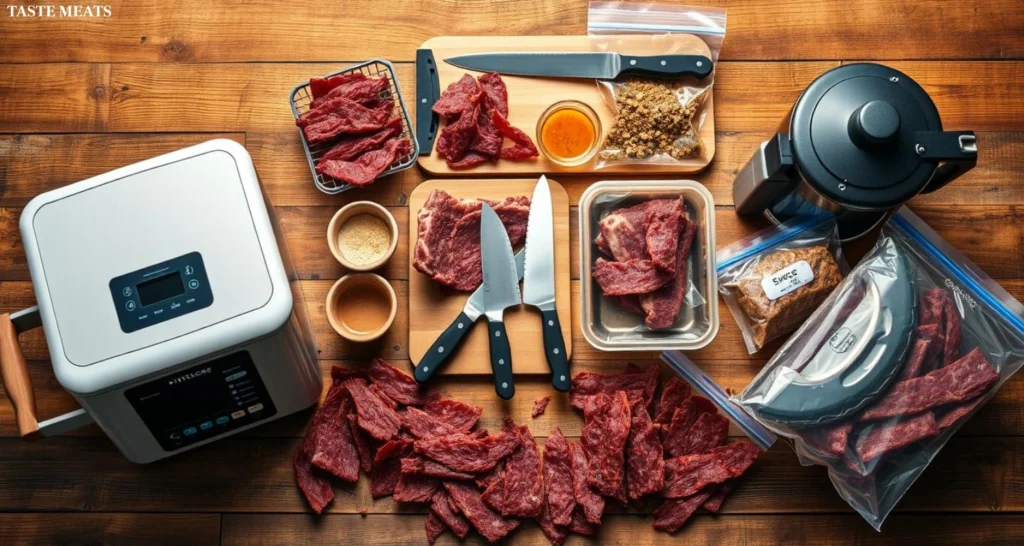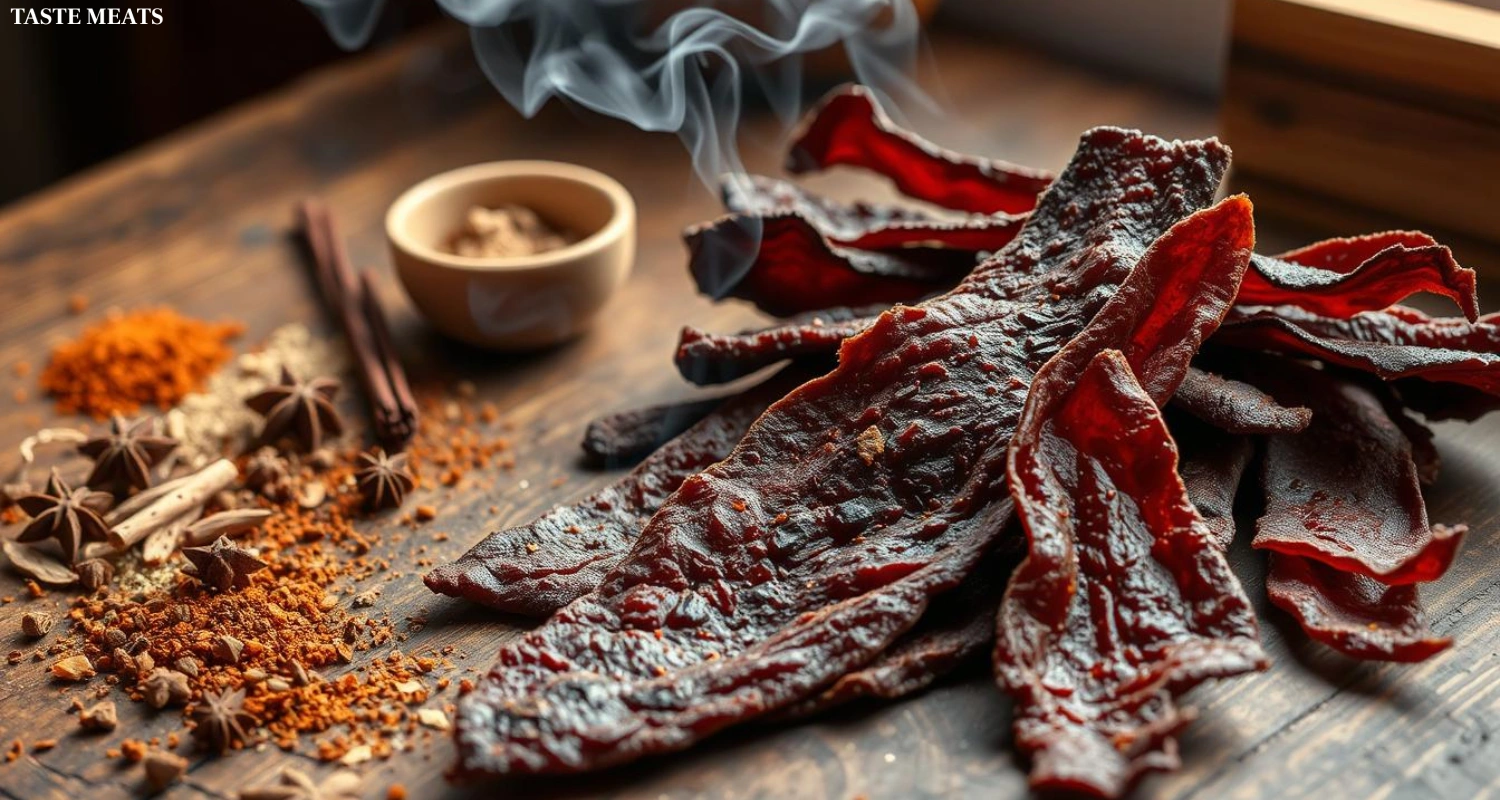I love spending time outdoors and always look for snacks that are easy to carry. Beef jerky is perfect for this, but the store-bought kind is too expensive and unhealthy. Making my own homemade smoked beef jerky changed everything. It’s now my go-to snack, full of protein and made with care.
Table of Contents
Why Make Your Own Smoked Beef Jerky
Making your own smoked beef jerky at home has many benefits. It’s healthier and lets you control the ingredients and flavours. Homemade jerky doesn’t have preservatives or additives, making it a natural snack.
Health Benefits of Homemade Jerky
Beef jerky is a protein-rich snack, with 10 to 15 grams of protein per serving. It has only 80 to 100 calories and zero carbs. Making it at home means using high-quality beef and customizing it to fit your diet, like making it gluten-free or low-sodium.
Cost-Effectiveness vs. Store-Bought Options
Making your own smoked beef jerky is cheaper than buying it. Drying and smoking the beef takes time, resulting in a tasty snack that lasts for weeks.
Control Over Ingredients and Flavors
When you make your perky, you control the ingredients and flavours. You can try different marinades, seasonings, and wood chips, creating unique flavours, from classic teriyaki to spicy pepper blends.
Making homemade beef jerky is rewarding and lets you make it just how you like it. With time and effort, you can turn simple ingredients into a delicious snack that’s good for you.

Essential Equipment and Tools for Jerky Making
Making delicious homemade smoked beef jerky requires the right tools. Whether new to the process or experienced, the right setup is key to the perfect texture flavourer.
A reliable smoker is the base of your jerky-making journey. You can choose from electric, gas, charcoal, or pellet smokers. Electric smokers are easy to use, while charcoal or pellet models give a traditional smoky taste. Use wood chips like hickory, mesquite, apple, or cherry to add amazing aromas to your jerky.
You’ll also need a sharp knife or meat slicer to cut the beef into thin strips. Aim for strips between 1/8 and 1/4 inch thick. A non-reactive container is important for mixing the marinade with the meat. Don’t forget a meat thermometer to check the jerky’s internal temperature during smoking.
Cooling racks are crucial for drying the jerky. They help it get the chewy texture you want. With the right tools, you’ll make delicious beef jerky recipe dehydrator and smoking jerky to enjoy.
| Equipment | Purpose |
|---|---|
| Smoker (electric, gas, charcoal, or pellet) | Provides the heat and smoke to cook and flavor the jerky |
| Wood chips (hickory, mesquite, apple, cherry) | Imparts smoky aroma and taste to the jerky |
| Sharp knife or meat slicer | Allows for precise, even slicing of the beef |
| Non-reactive marinating container | Ensures the marinade blends seamlessly with the meat |
| Meat thermometer | Monitors the internal temperature of the jerky during smoking |
| Cooling racks | Enables proper air-drying and texture development of the jerky |

Selecting the Perfect Cut of Beef
The right beef cut is key to making tasty beef jerky at home. Lean cuts are best for drying properly and avoiding spoilage. Top round, flank steak, sirloin tip, and eye of the round are top picks.
Top Recommended Cuts for Beef Jerky
- Eye of Round: This cut is renowned for its tenderness, making it an excellent choice for beef jerky.
- Bottom Round: While slightly less tender than the eye of the round, the bottom round offers more flavour due to its interior marbling.
- Top Round: A popular selection among commercial jerky companies, the top round balances tenderness, and flavour.
- Sirloin Tip: Though slightly pricier, sirloin tip is recognized as the most tender round cut and provides excellent beef flavour.
- Flank Steak: Extremely flavorful and lean, flank steak requires careful trimming for optimal results in beef jerky.
Trimming and Fat Content Guidelines
When preparing the meat for jerky, trim any visible fat. Lean cuts are preferred for a longer shelf life and better texture. Aim for uniform slices about 1/4 inch thick for even drying and smoking.
Meat Preparation Tips
For the best results, slice the meat against the grain for a more tender jerky or with the grain for a chewier texture. Sourcing your meat locally can also enhance the flavour and quality of your homemade beef jerky.

Mastering the Marinade Process
The marinade is key to making tasty homemade beef jerky. It involves soaking the meat in a mix of savoury sweet, and aromatic ingredients, which creates flavours that store-bought beef jerky marinades can’t match.
To make a great marinade, start with salty items like soy sauce and Worcestershire sauce. Add sweeteners like brown sugar and honey. Then, include acidic ingredients like vinegar or citrus juice. Don’t forget aromatic spices and herbs. Mix everything well so the meat is fully covered in the liquid.
| Ingredient | Amount |
|---|---|
| Soy sauce | 1 cup |
| Worcestershire sauce | 1/2 cup |
| Honey | 1/4 cup |
| Brown sugar | 1/4 cup |
| Apple cider vinegar | 2 tablespoons |
| Crushed red pepper flakes | 2 teaspoons |
| Garlic powder | 1 teaspoon |
| Onion powder | 1 teaspoon |
| Ground black pepper | 1 teaspoon |
After mixing the marinade, put the meat in a bag or container. Refrigerate it for at least 4 hours or overnight for better, don’t over-marinate to avoid salty or mushy homemade beef jerky.
With the right marinade and soaking time, you’re ready to make the best beef jerky marinade for your homemade jerky.
Smoked Beef Jerky: The Ultimate Recipe Guide
Making perfect smoked beef jerky is a tradition. Our expert tips will help you become a pro at this tasty snack. Try different recipes like Teriyaki, Spicy Pepper Blend, and Smokehouse.
Classic Teriyaki Style
This recipe mixes soy sauce, brown sugar, garlic, and ginger to create a perfect balance of the beef for 12 hours for the best taste.
Spicy Pepper Blend
For those who love spice, our Spicy Pepper Blend is perfect. It has hot chilli sauce, red pepper flakes, and cumin. Marinate for at least 12 hours for the best flavour
Traditional Smokehouse Recipe
This recipe sticks to the basics: salt, black pepper, and garlic powder. It lets the meat’s natural flflavorshine. Marinate for 8-10 hours for the best taste.
Choose any recipe and watch the jerky’s temperature. Aim for 160-180°F (70-82°C) for the best tenderness and flavor. Cut the beef to 1/4 inch for even drying. With patience and care, you’ll make delicious homemade jerky.
Mahogany Smoked Meats has over 100 years of experience. It’s known for its top-notch beef jerky marinade and smoking skills. It’s the #1 place to buy beef jerky online.
Temperature Control and Smoking Techniques
Getting the right temperature is key to making great beef jerky. For slow cooking, keep the heat between 160-180°F (70-82°C). This lets the meat soak up the smoky flavour.
Place the marinated beef slices on the smoker racks without stacking them. This ensures they get even smoke. Smoking time varies from 4 to 6 hours, based on meat thickness and smoker type.
Use a meat thermometer to check the jerky’s internal temperature. It should crack when bent but not break in half, so it’s cooked just right.
| Smoking Technique | Temperature Range | Smoking Time |
|---|---|---|
| Hot Smoking | 190°F – 300°F | 4-6 hours |
| Cold Smoking | Less than 120°F | Longer periods |
Learning to control temperature and smoking techniques is crucial. It helps make delicious, tender, and long-lasting beef jerky at home. Following these tips, you can make your homemade smoking jerky a hit with your loved ones.
Wood Selection for Optimal Flavor
Choosing the right wood is key to great-tasting smoked jerky. With over a century of experience, Mahogany Smoked Meats knows how to pick the best wood for beef jerky. Let’s look at the different woods and what they bring.
Different Wood Types and Their Impact
For smoking beef jerky, hickory, mesquite, applewood, and cherrywood are top picks. Each wood gives a unique flavour:
- Hickory gives a strong, classic smoke taste.
- Mesquite adds a bold, intense smoke that matches beef’s boldness.
- Applewood makes the jerky taste milder and sweeter, with fruity notes.
- Cherrywood adds a delicate, sweet-smoke flavour that complements beef.
Mahogany Smoked Meats uses mahogany logs to create a unique flavour in its jerky. This choice gives their products a complex taste.
Smoke Intensity Control
Getting the smoke intensity just right is important for perfect flavour. Smoke jerky between 160°F and 180°F for 4 to 6 hours. This ensures it dries well and absorbs flavours.
Adjusting wood chips and smoking time lets you customize the flflavorThis way, you can make smoked beef jerky, which is just right for you.
You can make amazing smoked beef jerky with the right wood and careful smoking. It will be a hit with your taste buds.
Storage and Preservation Methods
Keeping your homemade beef jerky fresh and safe is key. Cool it down completely before storing it. Store it in airtight containers or vacuum-sealed bags. Refrigerate it for up to 2 weeks or freeze it for up to 6 months.
Make sure the jerky is dry to avoid mould. For better storage, add moisture-absorbing packets. If you freeze it, thaw it in the fridge overnight before eating.
Homemade beef jerky can stay fresh for 1-2 months in a cool, dry spot. Vacuum-sealed jerky can last up to 6 months in the pantry or a year in the fridge. Freezing it can keep the quality for months.
Techniques like refrigeration, freezing, or vacuum sealing helps keep your jerky tasty and safe and preserve its texture and flavour.
Canned beef jerky stays fresh longer without needing the fridge. Storing it in an airtight container keeps bacteria away, making it safe to eat. Storing in bulk can also save you money, making it a great snack option.

